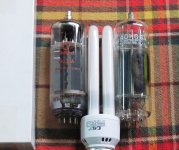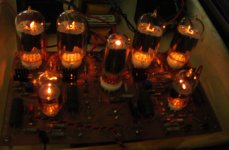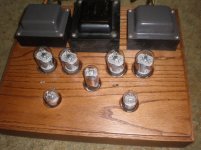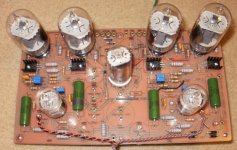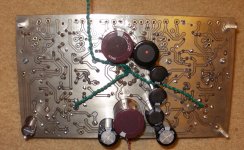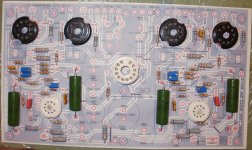Never used 'em myself. I prefer solid state for DC. One junk box design I did used the 5U4GB since the PTX had the current capability, but over volted badly with Si diodes, and I needed to lose 100V. Turned out this PTX must've been designed for use with 5U4GBs, CLC ripple filter, to make 350Vdc. That's what I needed, and that's what I got, so that worked out just fine. I also have a bunch of 5U4GBs, but so far, haven't needed to replace the original (Realistic Brand, but who knows who actually made it since Realistic bought up factory seconds, stuck bases on them, and their name and logo and sold them through Rat Shack.)
This really isn't such a swell idea. In the first place, red hot aluminum oxide becomes somewhat of an N-type semiconductor that could leak AC into the other heaters, including the low level stages.
Heater/cathode shorts do happen. It's still a good idea to run your 6.3V dampers from their own heater PTX. As added advantage is that you can connect the cathode to the heaters and remove the Vhk problem completely (of course, your heater PTX would need to be able to stand up to the high voltage).
They've been using these damper diodes to make hollow state bridges for many a dog's ages. Lots of ham rigs that needed bigvolts, or made use of "economy" type power supplies used these. That was before Si diodes, and there wasn't any other choice here. (They did have those selenium SS diodes but there were a lot of problems with these thingies, including toxic smoke when one poofed.)
but there were a lot of problems with these thingies, including toxic smoke when one poofed.)
Next, as they're indirectly heated, have 6.3V filaments, and (generally) high h-k voltages, you can use the same trafo winding as your other tubes' heaters – (no need for a separate 5V supply!)
This really isn't such a swell idea. In the first place, red hot aluminum oxide becomes somewhat of an N-type semiconductor that could leak AC into the other heaters, including the low level stages.
Heater/cathode shorts do happen. It's still a good idea to run your 6.3V dampers from their own heater PTX. As added advantage is that you can connect the cathode to the heaters and remove the Vhk problem completely (of course, your heater PTX would need to be able to stand up to the high voltage).
I know Lynn Olson is also a big proponent of dampers; I'd like to think he got the idea from me, rather than the other way around.
(Actually, it's probably more like an Alexander Graham Bell/Elisha Gray thing).
P.S.: Lately, I've been really liking the Russian 6Д22С, 6Д20П, and 6Ц19П dampers. (Yeah, plate caps are inconvenient, but their price/performance is worth it).
They've been using these damper diodes to make hollow state bridges for many a dog's ages. Lots of ham rigs that needed bigvolts, or made use of "economy" type power supplies used these. That was before Si diodes, and there wasn't any other choice here. (They did have those selenium SS diodes
 but there were a lot of problems with these thingies, including toxic smoke when one poofed.)
but there were a lot of problems with these thingies, including toxic smoke when one poofed.)Agreed. Never said you should use the same supply, just that you can (and there might be applications where it would be appropriate).This really isn't such a swell idea. In the first place, red hot aluminum oxide becomes somewhat of an N-type semiconductor that could leak AC into the other heaters, including the low level stages.
Absolutely. But if you've have to run your dampers off a 6.3 winding from a trafo that's already in use, use the one whose HT is feeding their anodes – that way, you can phase the heater AC to cancel some of the hum from the HT in.... It's still a good idea to run your 6.3V dampers from their own heater PTX...
Yep – I used to be able to pick up dampers at a hamfests for 10¢ a piece.They've been using these damper diodes to make hollow state bridges for many a dog's ages. Lots of ham rigs that needed bigvolts, or made use of "economy" type power supplies used these.
...and they did "poof" (more often then not). My first 40 meter rig was an old Hammerlund that had seleniums. Never considered the toxicity of the smoke at the time – (this was back when lead paint chips were still part of some kids' diets) – but they didn't smell good when they went. Anyway, I replaced the recs and caps in that thing PDQ-ly.That was before Si diodes, and there wasn't any other choice here. (They did have those selenium SS diodesbut there were a lot of problems with these thingies, including toxic smoke when one poofed.)
Last edited:
> > I know Lynn Olson is also a big proponent of dampers; I'd like to think he got the idea from me, rather than the other way around.
(Actually, it's probably more like an Alexander Graham Bell/Elisha Gray thing). << Quote
I've known about this for years an came to the same conclusion myself. I did the same with other tubes like the 807 - while everyone was buying 6L6 and KT66 I bought a swag of original sweet sounding tubes that won the 2nd world war and was built off the 6L6. Anything with a top cap used by the Military is far better than no top cap used in domestic applications.
Again the same with 6CM5's and a host of other frame grid triodes.
I've also even seen a 1S2 EHT rectifier used in a crystal set as the main detector!
It would handle lightning strikes better than any germanium diode and works quite well too.
The only issue I have with damper diodes is - they're technically pulse rated tubes and hence have a limited plate dissipation - but in saying that - they are very good for bench power supplies and HV rectifier work at low currents. Basically I love them for these sorts of applications!
(Actually, it's probably more like an Alexander Graham Bell/Elisha Gray thing). << Quote
I've known about this for years an came to the same conclusion myself. I did the same with other tubes like the 807 - while everyone was buying 6L6 and KT66 I bought a swag of original sweet sounding tubes that won the 2nd world war and was built off the 6L6. Anything with a top cap used by the Military is far better than no top cap used in domestic applications.
Again the same with 6CM5's and a host of other frame grid triodes.
I've also even seen a 1S2 EHT rectifier used in a crystal set as the main detector!
It would handle lightning strikes better than any germanium diode and works quite well too.
The only issue I have with damper diodes is - they're technically pulse rated tubes and hence have a limited plate dissipation - but in saying that - they are very good for bench power supplies and HV rectifier work at low currents. Basically I love them for these sorts of applications!
Last edited:
>> Lately, I've been really liking the Russian 6Д22С, 6Д20П, and 6Ц19П dampers. (Yeah, plate caps are inconvenient, but their price/performance is worth it). << Quote
As for Russian tubes - I recently bought off ebay some NOS 6P3C tetrodes to play with. ( supposed 6L6 equivalent.) When they arrived, they were dated from 1973-1988 and for about $7 dollars AUD ( $6 USD ) a piece. So I can't complain.
For the price they had a nice build quality and looked very sturdy and clean. The few write ups about them seem Ok so far, but good application data is hard to find in English on any Russian tube. The tubes came with a Russian data sheet in the box - but that was rather useless, as I can't read Russian.
Honestly - I would buy Russian tubes over Chinese any day, as they seem a far better build. Not interested in the gold glint looking bases and grids you get with Chinese tubes in cherry wood boxes - I'm more interested in brutal abuse taking for playing heavy metal music at full volume.
Military grade Russian tubes seem to be able to cope with that sort of electrical abuse.
As for Russian tubes - I recently bought off ebay some NOS 6P3C tetrodes to play with. ( supposed 6L6 equivalent.) When they arrived, they were dated from 1973-1988 and for about $7 dollars AUD ( $6 USD ) a piece. So I can't complain.
For the price they had a nice build quality and looked very sturdy and clean. The few write ups about them seem Ok so far, but good application data is hard to find in English on any Russian tube. The tubes came with a Russian data sheet in the box - but that was rather useless, as I can't read Russian.
Honestly - I would buy Russian tubes over Chinese any day, as they seem a far better build. Not interested in the gold glint looking bases and grids you get with Chinese tubes in cherry wood boxes - I'm more interested in brutal abuse taking for playing heavy metal music at full volume.
Military grade Russian tubes seem to be able to cope with that sort of electrical abuse.
> > I know Lynn Olson is also a big proponent of dampers; I'd like to think he got the idea from me, rather than the other way around.
(Actually, it's probably more like an Alexander Graham Bell/Elisha Gray thing). << Quote
I've known about this for years an came to the same conclusion myself. I did the same with other tubes like the 807 - while everyone was buying 6L6 and KT66 I bought a swag of original sweet sounding tubes that won the 2nd world war and was built off the 6L6. Anything with a top cap used by the Military is far better than no top cap used in domestic applications.
Again the same with 6CM5's and a host of other frame grid triodes.
I've also even seen a 1S2 EHT rectifier used in a crystal set as the main detector!
It would handle lightning strikes better than any germanium diode and works quite well too.
The only issue I have with damper diodes is - they're technically pulse rated tubes and hence have a limited plate dissipation - but in saying that - they are very good for bench power supplies and HV rectifier work at low currents. Basically I love them for these sorts of applications!
Dampers have both average and peak ratings. As long as the average ratings are observed they work fine. Thanks to their extremely rugged cathodes and low voltage drop (which equals low dissipation compared to a filamentary diode for a given RMS current) they can supply quite a lot of current.
SCREEN GRID DRIVE
I have several pairs of transformers from 6L6GB and 6L6GC amps, pentode mode.
I would like to do screen drive. I have read that TV sweep tubes? are generally ideal for this.
Any recommendations? I have several power transformers good for 400+ volts as they came from 6L6GC applications.
I have the schematic for the drive circuit already. I'm not sure if the GU50 would be suitable in this case as it seemed to sound better with 65 to 70 ma idle current per tube, so that might be excessive for the transformers, unless anyone has experience with the GU50 that dictates otherwise. I have only built the one power amp using GU50s, so the fact that it sounded better with 65 ma (versus 40 ma) might have been more due to the OPT than the tubes.
If this has already been covered, kindly redirect me. thx
I have several pairs of transformers from 6L6GB and 6L6GC amps, pentode mode.
I would like to do screen drive. I have read that TV sweep tubes? are generally ideal for this.
Any recommendations? I have several power transformers good for 400+ volts as they came from 6L6GC applications.
I have the schematic for the drive circuit already. I'm not sure if the GU50 would be suitable in this case as it seemed to sound better with 65 to 70 ma idle current per tube, so that might be excessive for the transformers, unless anyone has experience with the GU50 that dictates otherwise. I have only built the one power amp using GU50s, so the fact that it sounded better with 65 ma (versus 40 ma) might have been more due to the OPT than the tubes.
If this has already been covered, kindly redirect me. thx
Screen grid drive usually allows designers to use less than the typical idle currents for the tubes. So that should be OK. The GU-50 has about 1/2 or less of the g1 gm of the typical TV sweep tubes, which gives it good linearity for g1 drive (less closely spaced g1 to cathode). But for g2 drive it has 1/2 to 1/3 the gm2 of the typical TV sweep tubes. Since g2 drive is already quite linear for any of the tubes, the lower gm2 of the GU-50 just makes for difficult screen grid drive swing. The higher voltage swing required on g2 would also cause the plate V to drop well below the peak g2 voltage, causing some screen current excess.
Most any of the TV sweep tubes with a 220V max screen voltage rating (or lower) should work fine for screen grid drive mode. Look for ones which give the g1 curve set at 150 V on g2 (or lower). Also, look for ones with low screen currents.
Some tubes that have been tried in the past or recently: 6LQ6, 6HJ5, 35LR6, 26LW6, 26HU5, 21/33JV6 (and similar: 21HB5, 6GY5, 21JZ6), 6JN6 (and similar: 12GE5, 6JM6, 6DQ6B, 6GV5) or are still on the $1 list: 13GB5, 16/21GY5, 21/29KQ6, 17GJ5
Plenty of other sleepers around too. G2 drive candidates have not been well explored.
Most any of the TV sweep tubes with a 220V max screen voltage rating (or lower) should work fine for screen grid drive mode. Look for ones which give the g1 curve set at 150 V on g2 (or lower). Also, look for ones with low screen currents.
Some tubes that have been tried in the past or recently: 6LQ6, 6HJ5, 35LR6, 26LW6, 26HU5, 21/33JV6 (and similar: 21HB5, 6GY5, 21JZ6), 6JN6 (and similar: 12GE5, 6JM6, 6DQ6B, 6GV5) or are still on the $1 list: 13GB5, 16/21GY5, 21/29KQ6, 17GJ5
Plenty of other sleepers around too. G2 drive candidates have not been well explored.
Last edited:
So, it looks like the 6DQ6 aka 6GW6 will work great for me as they seem to be very much like a 6L6GC. I believe I can make a cathode follower or MOSFET source follower with no coupling cap between screen and cathode(source), so this should be a pretty easy build. Am I missing anything? This will be my first screen drive. I have a good circuit that will provide a pretty hefty voltage swing to drive the screen.
latest amp design running set of 17jt6 outputs, will also run 13gb5 outputs with a couple jumpers
Attachments
Last edited:
To use those Horizontal Output Tubes in Audio.
Application data for the 6DQ6A
http://www.retrovox.com.au/6dq6aamp.pdf
Note: This comes from the Radiotronics magazine which was published by the Sydney Australia AWV Tube Factory and whose Chief Engineer was Fritz Langford Smith of RDH fame.
The 6DQ6 was one of those 18 Watters which folk look at and say surely its more like a 24 Watter (The 6DQ6A data say 16W and the 6DQ6B says 18W)- it seems that AWV Factory who actually made these tubes agreed.
Cheers,
Ian
Application data for the 6DQ6A
http://www.retrovox.com.au/6dq6aamp.pdf
Note: This comes from the Radiotronics magazine which was published by the Sydney Australia AWV Tube Factory and whose Chief Engineer was Fritz Langford Smith of RDH fame.
The 6DQ6 was one of those 18 Watters which folk look at and say surely its more like a 24 Watter (The 6DQ6A data say 16W and the 6DQ6B says 18W)- it seems that AWV Factory who actually made these tubes agreed.
Cheers,
Ian
The 13GB5 will take 35 watts before the onset of glow.
That depends on who made the tube. Most of the "American brands" are Mullard made tubes and they indeed will take 30+ watts without glow. I have extracted over 100 watts from a pair for an hour without plate or screen glow. I have over 100 tubes and have tested about a dozen. They are all the same.
I have one used Matsushita (Panasonic) tube that will start to glow at about 25 watts.
I have several new unbranded "Made in Korea" tubes that glow unevenly and at different power levels from 18 to 25 watts.
One of the great secrets of the type is that is has an U shapes anode whitin the anode. that is spot welded to the outer anode. This anode takes all the heat when you load one whit 60 watts.
You might find this interesting PL500
Now that I think of it. I have recently bought a 300 volt 2A CC/CV lab supply. I ought to fry a weak PL500/504 to find out what they can take..
Pictures to follow....
You might find this interesting PL500
Now that I think of it. I have recently bought a 300 volt 2A CC/CV lab supply. I ought to fry a weak PL500/504 to find out what they can take..
Pictures to follow....
Has anyone tried torturing the Russian equivalent of the EL500/6GB5? They're way cheap and look well-made. I've helped myself to a few, but haven't gotten around to using any yet.
Note - there are two Russian tubes touted as EL500 equivalents - the 6P36S and the 6P44s. I think I have the 6P44s.
Note - there are two Russian tubes touted as EL500 equivalents - the 6P36S and the 6P44s. I think I have the 6P44s.
Last edited:
Those U shaped fixtures attached to the anode are called Barkhausen plates. They alter the path length from cathode to plate for various electron trajectories. They prevent UHF Barkhausen oscillations from occuring by de-cohereing the electron oscillations thru the screen grid.
I have tested some 12GE5 and 21HB5 tubes, which also (most TV sweeps do) have internal the Barkhausen plates. The Barkhausen plates get hot before the plate does.
12GE5 starts red plating (the internal B plates) at around 25 Watts.
21HB5 starts red plating (the internal B plates) at around 30 Watts.
Since a lot of the bigger TV sweeps have similar plate cross-sections (in the 1.5 inch diameter envelopes), I have been measuring the length of the plate for some to estimate the red plate limit:
12GE5 28.4 mm 25 W
21HB5 33.7 mm 30 W
6HJ5 35.5 mm ??
21LG6 35.5 mm ??
35LR6 40.5 mm ??
6LB6 46.3 mm ??
26LW6 ?? ??
I have tested some 12GE5 and 21HB5 tubes, which also (most TV sweeps do) have internal the Barkhausen plates. The Barkhausen plates get hot before the plate does.
12GE5 starts red plating (the internal B plates) at around 25 Watts.
21HB5 starts red plating (the internal B plates) at around 30 Watts.
Since a lot of the bigger TV sweeps have similar plate cross-sections (in the 1.5 inch diameter envelopes), I have been measuring the length of the plate for some to estimate the red plate limit:
12GE5 28.4 mm 25 W
21HB5 33.7 mm 30 W
6HJ5 35.5 mm ??
21LG6 35.5 mm ??
35LR6 40.5 mm ??
6LB6 46.3 mm ??
26LW6 ?? ??
One of the great secrets of the type is that is has an U shapes anode whitin the anode.
The U shaped piece is found in several of the 70's vintage sweep tubes. I have seen then inside 6LW6's and 35LR6's. I remember an explanation related to elimination of unwanted oscillations in sweep service. The larger sweep tubes also have fins welded to the outside of the plates to increase the surface area for IR radiation.
I have pushed a "40 watt" 6LW6 to 90 watts before the red glow of death appeared.
Has anyone tried torturing the Russian equivalent
I got my 13GB5 / XL500's for an average cost of 70 cents each, so I haven't looked at any alternatives. They work just fine on two Antek 6.3 volt windings in series. Low buck amp????? YES!
- Home
- Amplifiers
- Tubes / Valves
- Those Magnificent Television Tubes

